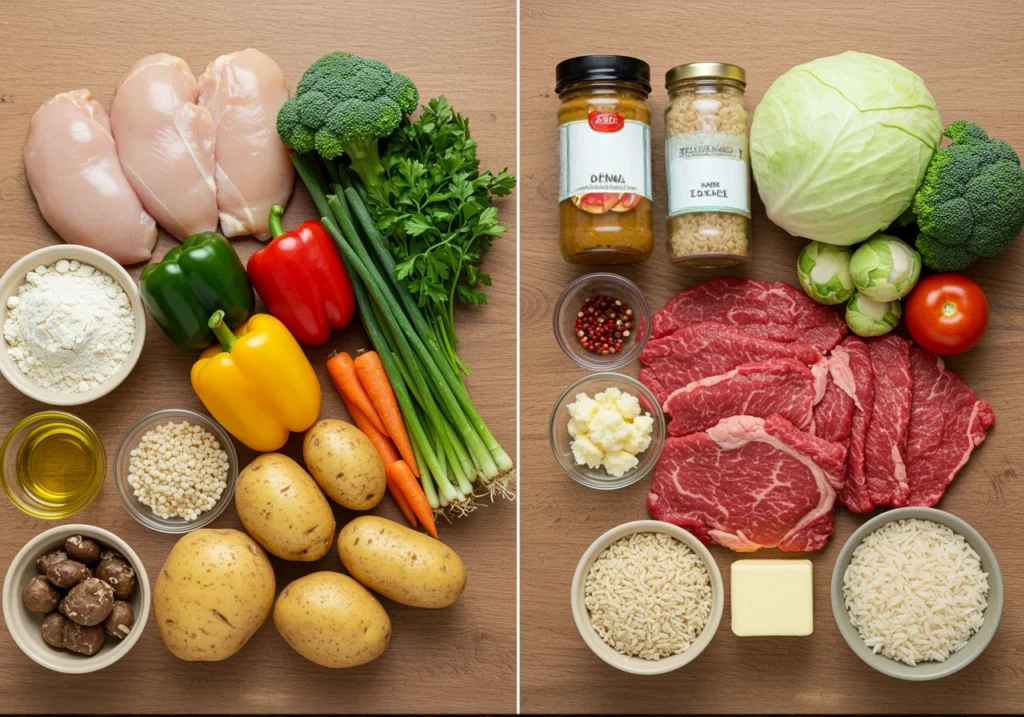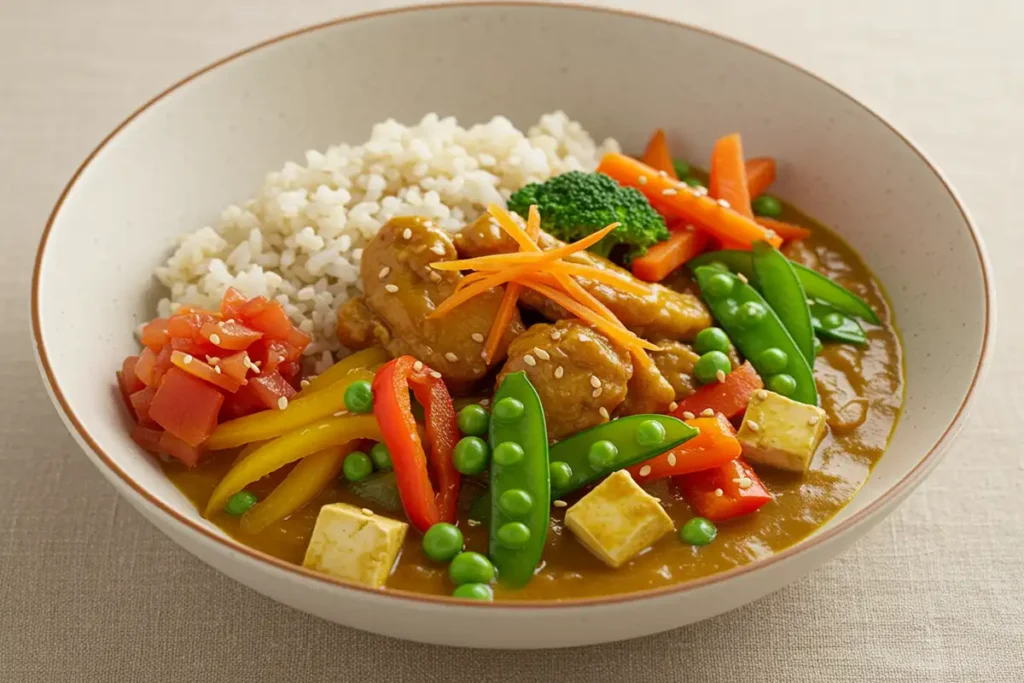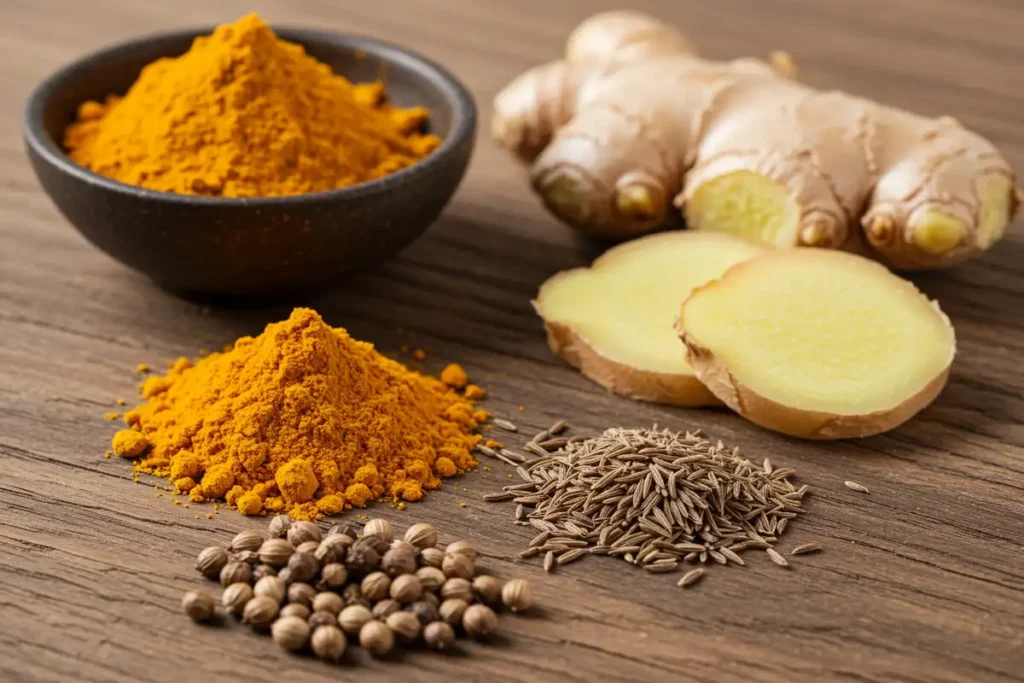Okay, amici! Let’s talk about something cozy and delicious: Japanese curry. Mamma mia, my family goes wild for it! It’s got that thick, slightly sweet, deeply savory thing going on that just hits the spot, especially on a rainy Portland evening. But you know, as much as we love it (and I mean, love it – even Luca cleans his plate!), that little voice in the back of my head sometimes whispers, “Is this actually… good for us?” So, let’s pour a glass of something nice and tackle the big question: Is Japanese curry healthy or unhealthy?
Now, hold your horses – there’s no simple “yes” or “no” answer here. Like most delicious things in life (hello, tiramisu!), it’s all about the ingredients, how much you pile onto your plate, and how often you’re digging in. We’re going to break it all down – the good, the maybe-not-so-good, and how you can still enjoy this amazing comfort food without totally ditching your wellness goals. Let’s get into it!
Understanding the Components of Japanese Curry
First things first, to figure out if Japanese curry is healthy or unhealthy, we gotta know what’s actually *in* it. It’s usually a delicious jumble of:
- The Roux Magic: This is the heart of the flavor and thickness! Those handy blocks you buy (or make from scratch) are typically a mix of flour, fat (like butter or oil), and a wonderful blend of spices – think turmeric, cumin, coriander, maybe some cardamom… yummy stuff!
- Protein Power: Often, you’ll find chicken (thighs stay nice and juicy!), beef, or pork swimming in that lovely sauce. Tofu or chickpeas work great for a veggie version too!
- Veggies Galore: Onions, carrots, and potatoes are the classic trio, giving it sweetness and body. But hey, throw in whatever you like – bell peppers, maybe some sweet potato, even spinach wilted in at the end!
- The Broth Base: Chicken, beef, or veggie broth forms the liquid part of the sauce, carrying all those flavors.
- Rice, Rice Baby: Almost always served over a fluffy pile of white rice (Japanese short-grain is perfect!).
See? It’s a mix! The final nutrition really depends on how you put these pieces together.
Potential Health Benefits of Japanese Curry
Okay, let’s talk about the good stuff first! Because yes, even comforting Japanese curry can bring some goodness to the table:
- Spice Power: Those spices in the roux aren’t just for flavor! Turmeric (hello, beautiful golden color!), cumin, coriander – they’re packed with antioxidants and have anti-inflammatory properties. Curcumin in turmeric is a real superstar, linked to all sorts of potential benefits. Want to know more about that golden goodness? Healthline has a great article on the benefits of turmeric.
- Veggie Boost: If you load it up with onions, carrots, potatoes, and maybe even sneak in some extra greens like spinach or peas, you’re getting a nice dose of vitamins, minerals, and fiber! Always a win in my book.
- Protein Punch: Whether it’s chicken, beef, or tofu, that protein helps keep you full and satisfied, plus it’s essential for building strong muscles (gotta keep up with Mia!).
- Keeps You Full: That combo of protein, carbs, and fat really sticks to your ribs, which can actually help prevent mindless snacking later. Mike definitely needs a hearty meal after a long day of teaching history!
So yes, there are definitely some pluses! But, like Nonna Rosa’s famous lasagna, it’s all about balance…
Potential Health Drawbacks of Japanese Curry
Alright, let’s be honest. While delicious, traditional Japanese curry can have a few things that make it lean towards the “sometimes treat” category rather than an everyday meal:
- Carb Overload: Between the flour in the roux and that big pile of white rice, it can be pretty heavy on the carbs. This can send your blood sugar on a rollercoaster, especially if you’re sensitive.
- Sodium Sneak Attack: Those convenient roux blocks? They can be loaded with salt! If you’re watching your sodium intake for blood pressure reasons, you gotta be mindful here.
- Fat Factor: The fat used to make the roux (often butter or oils) and sometimes fattier cuts of meat can add up, especially in the saturated fat department.
- Refined Stuff: Often, the roux uses white flour, and it’s served with white rice – these don’t offer as much fiber or nutrients as their whole-grain cousins.
- Portion Distortion: Mamma mia, it’s so easy to go back for seconds (or thirds!) because it’s just so darn comforting. Those portions can add up quickly!
So, enjoying it too often or in huge portions might not be the best move if you’re focusing on lighter eating.
Making Healthier Choices: Tips for a Nutritious Japanese Curry
But wait! Don’t despair! You can absolutely enjoy Japanese curry in a healthier way. It just takes a few little tweaks – think of it as giving your recipe a spa day:
- Read those Roux Labels: Compare brands! Some have lower sodium or fat options available. It takes an extra minute in the aisle but can make a difference.
- DIY Roux Power: Feeling ambitious? Make your own roux! Use whole wheat flour for extra fiber and control the amount and type of fat (olive oil works!).
- Lighten the Fat: If making your own roux, use less butter/oil. Skim any excess fat off the top before serving if using fattier meats.
- Veg Out!: Don’t be shy with the veggies! Add way more than the recipe calls for – broccoli, bell peppers, mushrooms, spinach, sweet potatoes, peas… Bulk it up with goodness!
- Lean Protein Choices: Go for skinless chicken breast or turkey. Use lean cuts of beef or pork. Tofu or lentils are fantastic plant-based options!
- Go Brown (Rice!): Swap the white rice for brown rice. You get more fiber and nutrients, and the nutty flavor is great with curry. Quinoa works too!
- Portion Patrol: Use a smaller bowl! Serve yourself a reasonable amount (maybe 1 cup of curry over 1/2 cup rice) and savor it slowly. Fill the rest of your plate with a green salad.
- Bean Boost: Stir in some chickpeas or kidney beans for extra plant-based protein and fiber. Yum!
Looking for a super easy way to try a lighter version? My Crock Pot Japanese Curry recipe is perfect for controlling the ingredients and letting the slow cooker do the work!
Comparing Japanese Curry to Other Curries
It’s interesting to think about how Japanese curry stacks up against others, like Indian or Thai. Honestly? They all have potential pros and cons!
- Indian Curries: Can be packed with veggies and amazing spices (super healthy!). But sometimes they use a lot of ghee (clarified butter) or heavy cream, bumping up the fat.
- Thai Curries: Often loaded with veggies and lean protein, and that coconut milk base is delicious! But they can sometimes be high in sugar or sodium, depending on the paste and sauces used.
Ultimately, no single type of curry is automatically “healthier.” It always comes down to the specific ingredients and how it’s prepared. Knowledge is power!
Addressing the FAQs: Clearing Up Common Misconceptions
Alright, let’s tackle some questions I hear a lot about Japanese curry and health:
How healthy is Japanese curry?
Japanese curry can be part of a healthy diet if it’s made with wholesome ingredients, in moderation, and with attention to portion size.
What is the healthiest curry for you?
The healthiest curry is one that is made with lots of vegetables, lean protein, whole grains, and minimal added fat, sugar, and sodium.
Is Japanese curry good for the stomach?
The spices in Japanese curry, such as ginger and turmeric, may have digestive benefits for some people. However, the high fat content may be problematic for others.
Is Japanese food healthy or unhealthy?
Japanese cuisine is generally considered to be quite healthy, with an emphasis on fresh, seasonal ingredients, lean protein, and minimal processed foods. However, some Japanese dishes, such as tempura and tonkatsu, can be high in fat.
Making Informed Choices: Enjoying Japanese Curry in Moderation
So, the final verdict on: is Japanese curry healthy or unhealthy? Like a good glass of Pinot Grigio, it’s all about context and moderation! It absolutely *can* fit into a healthy, balanced way of eating if you’re mindful about how you make it and how much you eat.
Load it with veggies, choose lean protein, maybe swap for brown rice, and watch those roux blocks. Enjoy it as a comforting meal, savor every bite, and don’t stress too much! Food is meant to be enjoyed, right? It’s about making smart choices most of the time so you can thoroughly enjoy those cozy curry nights. Buon appetito!



